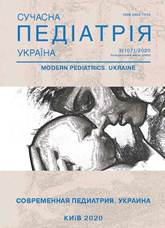Hemolytic-uremic syndrome as a complication of infectious diarrhea in children: clinical cases
Keywords:
children, toxic-toxicosis, intestinal infection, hemolytic-uremic syndromeAbstract
Hemolytic-uremic syndrome (HUS) is a serious complication of bacterial and viral diarrheal diseases, which is one of the causes of development of acute renal failure in children, and the effectiveness of its treatment and outcomes depend directly on the timeliness of diagnostics.Aim: To demonstrate the features of hemolytic&uremic syndrome in infants with infectious diarrhea.
Materials and methods. Two cases of GUS associated with diarrheal syndrome were analysed. In the first case manifestation was detected at the background of the rotaviral infection. In the second case — on the background of the toxicosis. Results of the examination, therapy, indicating the complexity of diagnosis and treatment are discussed.
Results and conclusions. In both cases, the disease began with diarrheal syndrome with hemocolitis. In the child with rotaviral infection with toxicosis and hemicolitis, the manifestations of HUS developed on the 4th day of the disease, and in the second child with acute intestinal infection of unexplained etiology with hemocolitis, manifestations of HUS developed on the 6th day of treatment. Subsequently, patients were examined and treated in the conditions of the department of chroniodialysis with hemodialysis. Patients underwent 17 and 14 hemodialysis sessions, respectively. To exclude thrombotic thrombocytopenic purpura (TTP), studies were conducted in Dr. Radger's laboratory for the presence of ADAMTS-13 antibodies. After treatment, children were discharged on the 56th and 51th days of the treatment. In 3 and 6 months after discharge from the hospital, children undergone full control examination, which revealed no deviations from the norm on all previously changed indicators. Their condition is stable. The results of the follow-up of children within 8 months indicate clinical and laboratory remission. During this time, they take ACE inhibitors for nephroprotection. Children remain under clinical observation with periodic monitoring of laboratory parameters over the next 5 years.
The research was carried out in accordance with the principles of the Helsinki Declaration. The study protocol was approved by the Local Ethics Committee of an participating institution. The informed consent of the patient was obtained for conducting the studies.
No conflict of interest was declared by the authors.
References
Baiko SV, Sukalo АV. (2016). Risk factors for poor outcome of hemolytic uremic syndrome in children. Nephrology and dialysis. 18;4: 404—414.
Baiko SV, Sukalo АV, Sudnovskaya KA. (2016). Hemolytic uremic syndrome in children: epidemiology, clinical and laboratory findings, treatment and outcomes (Single center study). Nephrology and dialysis. 18;3: 282—299.
Delyagin VM, Plyasunova SA. (2015). Hemolytic uremic syndrome. Consilium medicum. Pediatriya. 3: 23—28.
Ivanov DD, Korzh OM. (2014). Nefrolohiia v praktytsi simeinoho likaria. 3-ye vyd., pererob. i dop. D.: Vydavets Zaslavskyi OIu: 464.
Ivanov DD, Kushnirenko SV. (2014). Dytiacha nefrolohiia: navchalno-metodychnyi posibnyk. Dnipropetrovsk: Seredniak TK: 157—163.
Karpukhina OA, Kramar` LV, Arova AV, Nevinskij AB. (2015). Gemolitiko-uremicheskij sindrom kak oslozhnenie infekczionny`kh zabolevanij u detej: princzipy` diagnostiki i lecheniya. Lekarstvenny`j vestnik. 9;1(57): 10—16.
Kozlovskaya NL, Prokopenko EI, E`mirova KhM i dr. (2015). Klinicheskie rekomendaczii po diagnostike i lecheniyu atipichnogo gemolitiko-uremicheskogo sindroma. Nefrologiya i dializ. 17(3): 242—264.
Makoveczkaya GA, Mazur LI, Gasilina ES i dr. (2011). Monitoring zdorov`ya detej, perenesshikh gemolitiko-uremicheskij sindrom, kak faktor profilaktiki razvitiya i progressii khronicheskoj bolezni pochek. Pediatriya. 90;3: 6—12.
Nedelskaya S, Zoltán Prohászka, Yartseva D., Klyatskaya L et al. (2019). Hemolytic Uremic Syndrome in Pediatrics: Clinical Observation. Pediatrics. Eastern Europe. 7;3: 474—486.
Samarin DV. (2011). Hemolytic Uremic Syndrome in Children. Liky Ukrainy. 2(6): 21—22.
Emirova K, Tolstova EM, Kagan OM et al. (2016). Hemolytic uremic syndrome associated with shiga-toxin-producing Esherichia coli. Nephrology (Saint-Petersburg).20(2): 18—32.
An update for atypical haemolyticuraemic syndrome: diagnosis and treatment. Aconsensus document. (2013). Nefrologia. 33(1): 27—45.
KDIGO Clinical practice guideline for acute kidney injury kidney international supplements Volume 2/issue 1/ March 2016.
Niaudet P, Boyer O0G. (2015). Clinical manifestations and diagnosis of Shiga toxin — producing Escherichia coli (STEC) hemolytic uremic syndrome (HUS) in children. UpToDate.
Downloads
Issue
Section
License
The policy of the Journal “MODERN PEDIATRICS. UKRAINE” is compatible with the vast majority of funders' of open access and self-archiving policies. The journal provides immediate open access route being convinced that everyone – not only scientists - can benefit from research results, and publishes articles exclusively under open access distribution, with a Creative Commons Attribution-Noncommercial 4.0 international license (СС BY-NC).
Authors transfer the copyright to the Journal “MODERN PEDIATRICS. UKRAINE” when the manuscript is accepted for publication. Authors declare that this manuscript has not been published nor is under simultaneous consideration for publication elsewhere. After publication, the articles become freely available on-line to the public.
Readers have the right to use, distribute, and reproduce articles in any medium, provided the articles and the journal are properly cited.
The use of published materials for commercial purposes is strongly prohibited.

